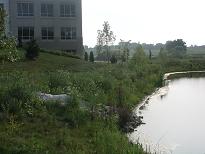Whose Pond is it Anyway?
A quick reference guide on maintaining your community's storm water pond and where to get more information.
- What is a storm water pond? Storm water ponds are one of several best management practices developers may choose to use for water quality and storm water capacity control, as mandated by state and local ordinances. Storm water ponds are typically part of the overall development plan and must be maintained in perpetuity.
- Maintaining your storm water pond
- Start by gathering information.
- Determine who is responsible for maintaining the pond. This may be spelled out in a maintenance agreement between the owner and local municipality, however, this may not be the case with all ponds.
- Obtain a copy of the engineering plans and any "as-built" surveys that exist. The local municipality or design engineer should be able to provide you this.
- Inspect the pond: This may require hiring someone with experience in certifying storm water ponds and assessing things like erosion, woody growth, burrows, soft spots, leakage, sediment accumulation, permanent pool depth, vegetation, etc.
- Maintenance
- Accumulated Sediment Removal may be required once sediment approaches the limit of available sediment storage as found in your maintenance agreement or storm water management plan. This will help ensure the pond functions as intended and is normally recommended when the level of sediment builds up within 1/2 foot of the available sediment storage level. Removal of accumulated sediment from storm water ponds may require state and local permits, here are examples of some state permits that may be required (please be advised this is not a complete list):
- Sediment sampling and disposal must meet solid waste rules and regulations. NR 528 Rule for accumulated sediment from storm water management ponds
- Pit Trench Dewatering General WPDES Permit: Industrial and municipal wastewater general discharge permits
Contact: Wastewater permits staff - Dredging Operations - Carriage and Interstitial Water General WPDES Permit: Industrial and municipal wastewater general discharge permits
Contact: Wastewater permits staff - Construction Site Storm Water Discharge General Permit for Land Disturbing Activities of 1 Acre or More:
Construction site erosion control and storm water management
Contact: Storm water permits staff - Ponds near waterways or wetlands: Waterway protection - ponds
Contact: Water management specialists
- Nuisance algae growth? Does your subdivision have lawn fertilizer guidelines? What does your lawn really need? Start with a soil test and check out these brochures:
- Lawn and Garden Fertilizers [PDF, Exit DNR] describes how improper fertilizer applications can degrade water quality and offers suggestions for proper fertilizer use.
- For areas over 5 acres see: Turf Nutrient Management
- Landscaping: Landscaping and vegetation to help with water quality, aesthetics and nuisance wildlife. See UWEX Publication GWQ045 [PDF, exit DNR].
- Aerators and Fountains: They must not interfere with the quiescent permanent pool required for water quality. For guidelines see: Wet Detention Basin Technical Standard 1001
- Aquatic Plant Management Chemical control for nuisance aquatic plants require a permit.
Contact: APM permits staff
- Accumulated Sediment Removal may be required once sediment approaches the limit of available sediment storage as found in your maintenance agreement or storm water management plan. This will help ensure the pond functions as intended and is normally recommended when the level of sediment builds up within 1/2 foot of the available sediment storage level. Removal of accumulated sediment from storm water ponds may require state and local permits, here are examples of some state permits that may be required (please be advised this is not a complete list):

